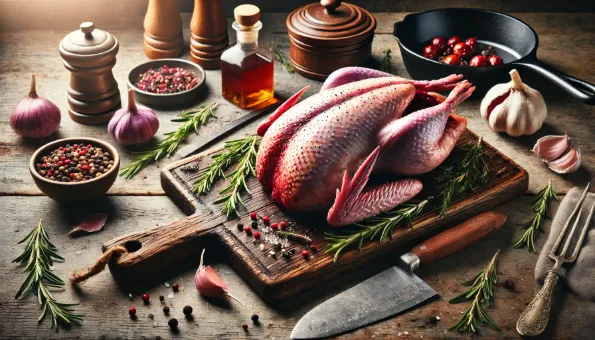Pheasant: Lean Game Bird Rich in Protein, Iron & B-Vitamins
With 26 g protein and only 2 g fat per 100 g cooked, pheasant offers a wild, slightly sweet flavour that shines in roasts, stews or terrines—just don’t over-cook the delicate breast.

What Is Pheasant?
Common (ring-necked) pheasant (*Phasianus colchicus*) is a ground-dwelling game bird. Meat from wild or estate-reared birds is darker than chicken, yet milder than duck.
Nutrition (per 100 g roasted, skinless)
| | Amount | %DV |
|---|---|---|
| Calories | 133 kcal | — |
| **Protein** | 26.1 g | 52 % |
| **Fat** | 2.0 g | 3 % |
| – Sat Fat | 0.7 g | 4 % |
| **Iron** | 2.4 mg | 13 % |
| Niacin (B3) | 7.5 mg | 47 % |
| Selenium | 28 µg | 51 % |
Potential Benefits
- **Very lean complete protein** for muscle repair with minimal fat.
- Higher **iron & selenium** than chicken—supports oxygen transport & immunity.
- Wild birds are generally **antibiotic-free** and free-range, offering varied micronutrient profile.
Drawbacks & Precautions
- Easily **dries out**; bard with fat or cook sous-vide.
- Check and remove any **lead shot** in wild birds.
- Gamey flavour may be new to some palates—pair with sweet fruit or wine sauces.
Culinary Uses
- Roast whole at 180 °C, 20 min, then rest.
- Braise legs in cider with root veg.
- Slice breast thin for stir-fries; marinate to maintain moisture.
- Combine minced pheasant with pork fat for lean sausage.
Storage Tips
Whole dressed bird: **2 days** at ≤ 2 °C; frozen up to **8 months**. Cooked meat keeps 3 days chilled.
Sustainability Notes
Wild-harvest pheasant has **low feed footprint**; estate birds fed local grain. Choose suppliers that avoid harmful lead ammunition and practise habitat conservation.
Key Takeaways
✔︎ 26 g lean protein/100 g
✔︎ Good iron & selenium
✖︎ Remove lead shot, avoid over-cooking.
- 1. Pheasant

